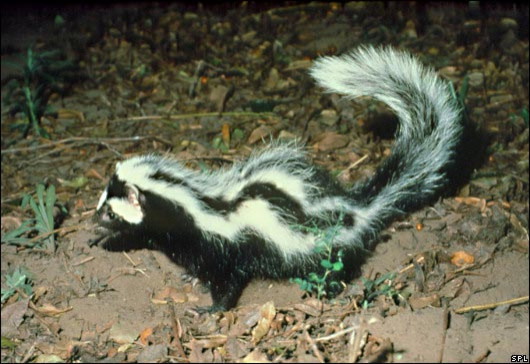When Nature Stinks: Corpse Flower and Dead Horse Lily Among Most Awful-Smelling Organisms On Earth
The stinky smell infusing the streets of Washington, D.C., isn’t the aroma of overripe tourists marinating in the humid swampy air; it’s the blooming of the U.S. Botanic Garden’s Amorphophallus titanium, also known as the corpse flower, which emits a putrid stench to attract pollinating flies.
The corpse flower or titan arum is, by some measures, the biggest flower on Earth. It doesn't adhere to a set blooming schedule -- years or even decades can pass between flowerings. After its pleated petals opened on Sunday, the corpse flower is expected to remain open for anywhere between 24 and 48 hours.
But the corpse flower isn’t the only stinky thing found in nature. Be sure to hold your nose if you meet any of these plants or animals out in the wild:
Dead horse lily (Helicodiceros muscivorus): Like the Corpse Flower, the name of this odiferous plant is dead on. This putrid purple blossom exudes a scent that mimics a carcass, seeking to lure carrion blowflies into its flowers. Once flies crawl into the fleshy, hairy lily, they’re trapped by spines that hold them prisoner overnight as the lily’s male parts kick into action. In the morning, the plant releases the flies, which have to pass through a gauntlet of male flower parts that liberally coat the insect in pollen.
To mimic a rotting carcass, the dead horse lily releases the same volatile chemicals that are spewed forth by decaying flesh. In fact, scientists have found that flies can't seem to tell the difference between an actual carcass and a dead horse lily. To prove even more enticing, the dead horse lily, like the corpse flower, can produce heat in a process called “thermogeny.” The heat is just as important as the smell to the plant’s disguise – rotting carcasses also emit heat, thanks to the seething mass of microbes eating away at the dead flesh.
Snake Lily (Dracunculus vulgaris): This plant is another close relative of the corpse flower -- it, too, smells like rotting flesh ---and is native to the Balkans. It’s also sometimes known as the Vampire Lily, the Dragon Arum, the Voodoo Lily or Dragonwort.

Striped polecat (Ictonyx striatus): The striped polecat, also known as the “zorilla,” can be found in the dry parts of sub-Saharan Africa. Its markings bear a strong resemblance to its cousin, the skunk, with which it shares another important feature: the ability to emit a strong, horrific odor from behind. The striped polecat has stink glands near its anus that produce a foul-smelling secretion; the resulting fumes can drive off both predators and innocent passersby. The smell clings to the polecat’s fur as well, meaning that anything that tries to take a bite out of a zorilla won't be getting a pleasant meal.

Bombardier beetles (Family Caribidae): These beetles have chambers in their behinds to store hydrogen peroxide and another chemical called hydroquinone. When something disturbs the beetle, they mix the two chemicals in another rear-end chamber, along with water and certain enzymes. The chemical reaction creates a hot, painful spray that allows the bug to make an escape.
Famed naturalist Charles Darwin complained of a close encounter with a bombardier beetle in an 1846 letter to English clergyman and naturalist Leonard Jenyns. Darwin had been out collecting insects, and had just caught two Caribidae specimens when he saw something even more enticing – the rare crucifix ground beetle, Panagaeus cruxmajor.
“I could not bear to give up either of my Carabi, & to lose Panagæus was out of the question, so that in despair I gently seized one of the carabi between my teeth,” Darwin wrote, “when to my unspeakable disgust & pain the little inconsiderate beast squirted his acid down my throat & I lost both Carabi & Panagæus!”
© Copyright IBTimes 2024. All rights reserved.





















